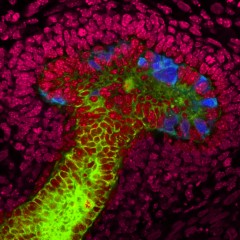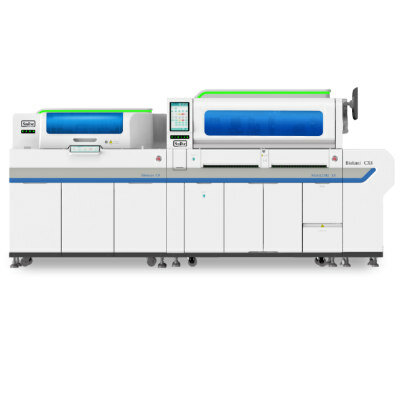Human Stem Cells Used to Generate Functional Kidney-Like Structures
By LabMedica International staff writers
Posted on 04 Dec 2013
A paper described the successful differentiation of human stem cells into functioning kidney-like structures.Posted on 04 Dec 2013
The high incidence of kidney disease and the poor prognosis support the urgent need for the development of new therapeutic strategies.

Image: Salk Institute scientists have grown human stem cells into early-stage ureteric buds. They used mouse embryonic kidney cells (seen here in red) to coax the human stem cells to grow into the nascent mushroom-shaped buds (blue and green) (Photo courtesy of the Salk Institute for Biological Studies).
Investigators at the Salk Institute for Biological Studies (La Jolla, CA, USA) described progress in the use of induced pluripotent stem cells (iPSCs) for kidney disease research in the November 17, 2013, online edition of the journal Nature Cell Biology.
They generated iPSCs from skin cells and then grew them in cultures laced with growth factors known to be linked to kidney development. The generated cells demonstrated rapid and specific expression of renal progenitor markers after four days of exposure to defined media conditions. Further maturation into ureteric bud structures was accomplished by employing a three-dimensional culture system in which the differentiated human cells assembled and integrated alongside mouse cells for the formation of chimeric ureteric buds. The ureteric bud is a protrusion from the mesonephric duct that appears during the development of the urinary and reproductive organs and eventually develops into the adult kidney.
“Attempts to differentiate human stem cells into renal cells have had limited success,” said senior author Dr. Juan Carlos Izpisua Belmonte, professor in the gene expression laboratory at the Salk Institute for Biological Studies. “We have developed a simple and efficient method that allows for the differentiation of human stem cells into well-organized three-D structures of the ureteric bud (UB), which later develops into the collecting duct system. Our results provide a new platform for the study of kidney diseases and lineage commitment, and open new avenues for the future application of regenerative strategies in the clinic.”
Related Links:
Salk Institute for Biological Studies














